|
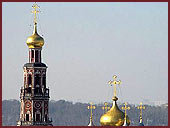 The
Novodevichy Convent (New Nunnery or Maiden), a 16-17th
century complex of 15 buildings, surmounted by golden domes,
is one of the oldest religious complexes in Moscow. The
Novodevichy Convent (New Nunnery or Maiden), a 16-17th
century complex of 15 buildings, surmounted by golden domes,
is one of the oldest religious complexes in Moscow.
It was here that women from the royal family and top-ranking
boyar families took the veil, thereby closely linking its
history with the life of the Russian state from the 16th to
early 18th centuries.
|
|
The Novodevichy Convent is situated on the inner side
of the horseshoe band of the Moscow River near the Devichye
(Maid's) field. The nunnery was called Novodevichy (New Maiden's)
to differ from Ascension Nunnery, called Starodevichy (Old
Maiden's).
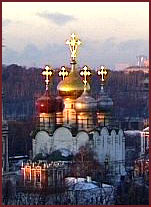 It
was established in 1524 as a monument to the freeing of Smolensk
(the main city on the way to the west, the city was freed
from the Litva in 1514, who had captured the town as early
as the beginning of the 15th century.) from Polish rule. It
was established in 1524 as a monument to the freeing of Smolensk
(the main city on the way to the west, the city was freed
from the Litva in 1514, who had captured the town as early
as the beginning of the 15th century.) from Polish rule.
The walls and the towers were erected in the end of
16th century during the reign of Boris Godunov. The architects
drew inspiration from the Kremlin and the Cathedral of the
Assumption. Boris Godunov's sister and the wife of Tsar Fyodor
Ivanovich Irina, all the sisters of Peter
I consecrated nuns there. The first wife of Peter I Evdokiya
Lopukhina ended her life in the nunnery.
|
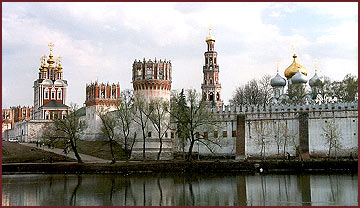
The Novodevichy Convent.
|
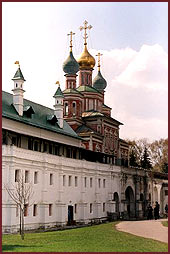 The
oldest building pictured is the Smolensk (translated as mother
of God) Cathedral (1524-25.) The prototype of this church was
the Moscow Cathedral of the Assumption. Designed by Aristotle
Fioravente, the construction of this monastery church architecturally
demonstrated the importance of Moscow to the State. The imitation
of the Kremlin Cathedral is evident in the similar division
of the walls into vertical sections, in the architecture frieze
with colonnades and in the cathedral's five domes. But this
imitation was only superficial. The
oldest building pictured is the Smolensk (translated as mother
of God) Cathedral (1524-25.) The prototype of this church was
the Moscow Cathedral of the Assumption. Designed by Aristotle
Fioravente, the construction of this monastery church architecturally
demonstrated the importance of Moscow to the State. The imitation
of the Kremlin Cathedral is evident in the similar division
of the walls into vertical sections, in the architecture frieze
with colonnades and in the cathedral's five domes. But this
imitation was only superficial.
|
|
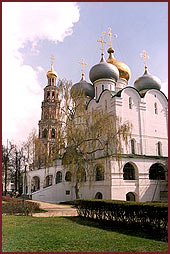 The exterior of the Cathedral has a more soaring structure,
and the interior pillars are square in plan, which increases
number of the soaring lines. The frescoes and icons of the
16th and 17th centuries have been preserved to this day.
The exterior of the Cathedral has a more soaring structure,
and the interior pillars are square in plan, which increases
number of the soaring lines. The frescoes and icons of the
16th and 17th centuries have been preserved to this day.
Russian architects created a festive ensemble by combining
traditional Russian architecture with some compositional devices
of the Moscow baroque architecture.
The Convent was part of the defense half-circle outside
the city (Donskoy, Danilov, Simonov, Novospassky and Andronikov
Monasteries). In 1922 the Nunnery was closed. Now it is a
museum, but part of it used as Nunnery.
|
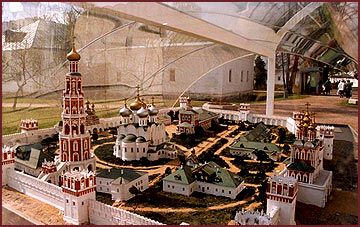 Model of the Novodevichy Convent, located
on its territory.
Model of the Novodevichy Convent, located
on its territory. 
|
 |
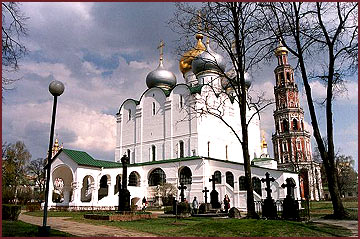 |
| The
Novodevichy Convent. Smolensk Cathedral. |

|
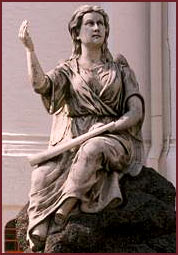 The
Novodevichy Convent Itself Is a unique 16th-17th The
Novodevichy Convent Itself Is a unique 16th-17th
century architectural ensemble. It is dominated by the huge
five domed Cathedral of the Smolensk Icon of Our Lady (1524
1525) which was modeled on the Cathedral of the Dormition in
the Kremlin. In the early 17th century,
during the reign of Boris Godunov, the walls of the cathedral
were ornamented with frescoes representing historic episodes
in the struggle for the formation of a centralized Russian state.
In the 1680s, K.Mikhailov and O. Andreyev together with a number
of other Russian master carvers created one of the finest ornamental
works of the period - a multitiered gilt carved icons, demonstrative
of their exquisite taste and tremendous skill.
|
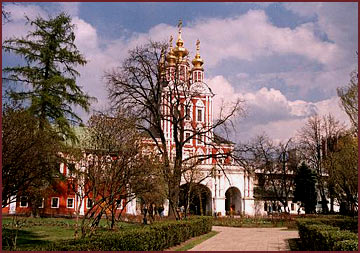
The Novodevichy Convent.
Church of the Protection.
|
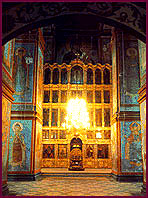 The
floor of the cathedral is made of ornamental cast-Iron plates.
The other structures - the refectory, the gateway churches,
the Irminskiye and Lopukhinskiye Chambers, and the cells were
also built In the 1680s. The decorative Moscow baroque style
serves to harmonize the buildings with the abundance of white-stone
ornamentation on the red-brick walls. The convent's bell tower
rivals the famous Bell Tower of Ivan the Great in the Kremlin
in its beauty. Elegant and highly decorative it was erected
in 1689-1690, and consists of six octagonal stepped tiers crowned
with a gilt cupola. Each tier is surrounded by a balcony with
a parapet supported by ornamental balusters. The
floor of the cathedral is made of ornamental cast-Iron plates.
The other structures - the refectory, the gateway churches,
the Irminskiye and Lopukhinskiye Chambers, and the cells were
also built In the 1680s. The decorative Moscow baroque style
serves to harmonize the buildings with the abundance of white-stone
ornamentation on the red-brick walls. The convent's bell tower
rivals the famous Bell Tower of Ivan the Great in the Kremlin
in its beauty. Elegant and highly decorative it was erected
in 1689-1690, and consists of six octagonal stepped tiers crowned
with a gilt cupola. Each tier is surrounded by a balcony with
a parapet supported by ornamental balusters.
|
As soon as the
convent was founded, a cemetery was opened on its grounds, which
subsequently became a traditional burial place for the church
dignitaries and feudal lords of Moscow.
 The graves of quite a few prominent public
and cultural figures famous in Russian history such as the Decembrists
M.Muravyov-Apostol, A.Muravyov and S. Trubetskoi, the poet Denis
Davydov who was a hero of the Patriotic War of 1812, have been
preserved in the burial grounds of the cloister. In 1898, the
so-called New Cemetery was established behind the south wall
of the convent. Surrounded by a wall in 1898-1904, it became
the most venerated cemetery in Moscow. Here lie the bodies of
outstanding writers, poets
and artists such as N.
Gogol, A. Chekhov, V. Bryusov and V. Mayakovsky, the artists
V. Serov and I. Levitan, as well as famous actors, scientists
and public figures. The graves of quite a few prominent public
and cultural figures famous in Russian history such as the Decembrists
M.Muravyov-Apostol, A.Muravyov and S. Trubetskoi, the poet Denis
Davydov who was a hero of the Patriotic War of 1812, have been
preserved in the burial grounds of the cloister. In 1898, the
so-called New Cemetery was established behind the south wall
of the convent. Surrounded by a wall in 1898-1904, it became
the most venerated cemetery in Moscow. Here lie the bodies of
outstanding writers, poets
and artists such as N.
Gogol, A. Chekhov, V. Bryusov and V. Mayakovsky, the artists
V. Serov and I. Levitan, as well as famous actors, scientists
and public figures.
The body of F. Shaliapin was transferred here from
France. The tombstones to be seen at the Novodevichye Cemetery
include works by the celebrated Russian sculptors.
|
|


